WWDC 2005 - Apple to Move to Intel Processors in 2006
by Anand Lal Shimpi on June 6, 2005 3:03 PM EST- Posted in
- Trade Shows
Steve talked about the two major challenges with the shift to x86:
At the conference, Apple released an updated version of their Xcode development suite. Xcode 2.1 will let you compile to both PowerPC and Intel architectures, creating a universal binary and allowing developers to ship one copy of software that supports both processors.
- Getting Mac OS X run on Intel
- Intel versions of Applications

OS X has been living a secret double life for the past 5 years.
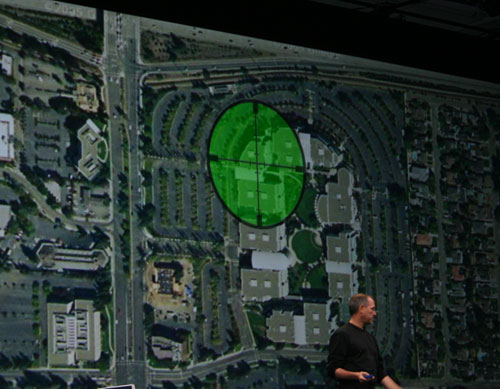
This picture highlights the building on Apple's Cupertino campus where x86 development has taken place for the past 5 years.
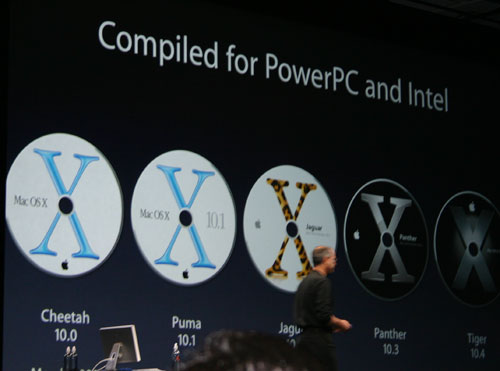
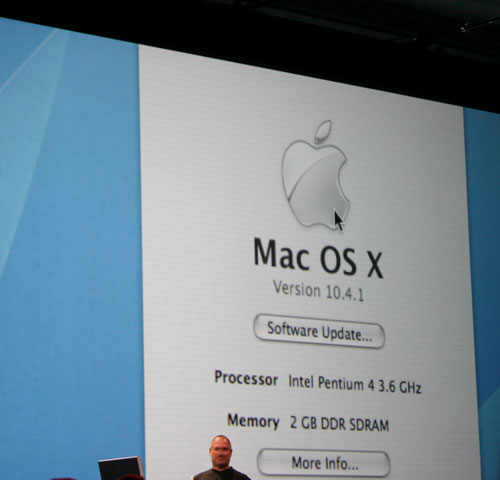
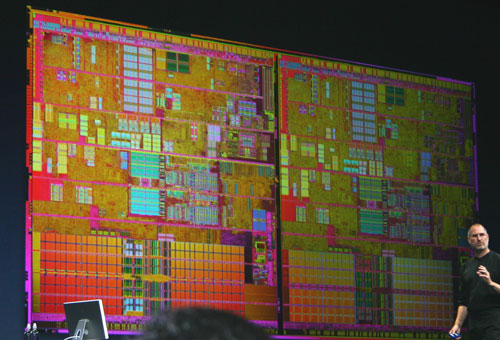
At the conference, Apple released an updated version of their Xcode development suite. Xcode 2.1 will let you compile to both PowerPC and Intel architectures, creating a universal binary and allowing developers to ship one copy of software that supports both processors.
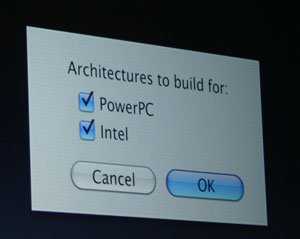
A checkbox in Xcode 2.1 will allow developers to create a universal binary that will run on both PPC and Intel platforms.
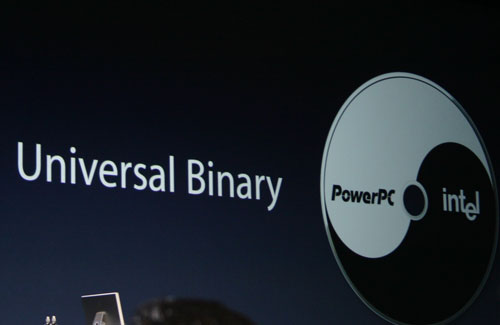

The transition in architectures will be an overlapping one.



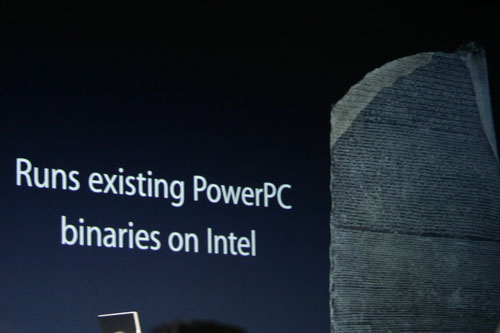
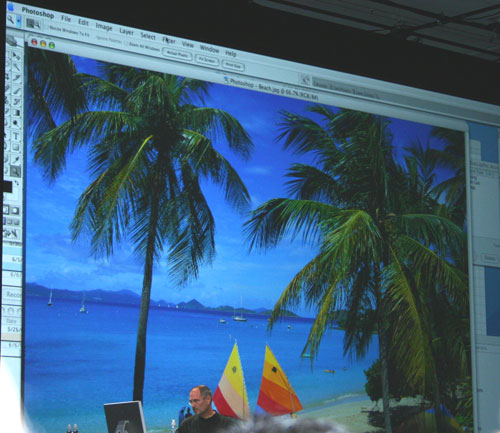
OS X (PowerPC) Photoshop running on an Intel OS X system using Rosetta.
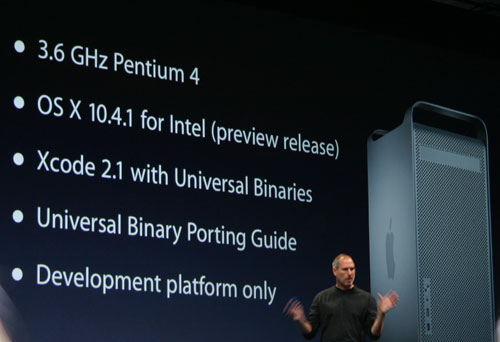
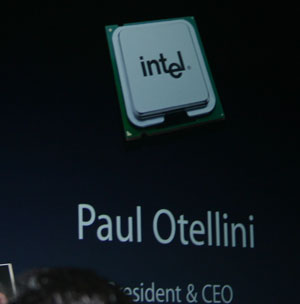

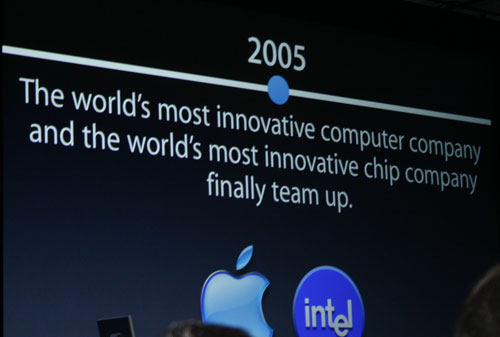
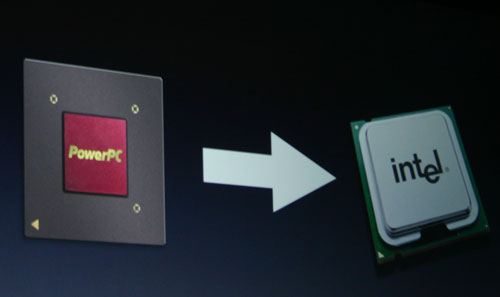










65 Comments
View All Comments
WooDaddy - Monday, June 6, 2005 - link
I didn't see Anand mention whether or not any booed the statement about switching to Intel. I would.I just switched and love it. Granted I'm using a Dell laptop right now, I'm saving my pennies for an ibook.
As far as Intel/AMD is concerned, it is about brand and supply. AMD has always had a tough time providing the supply that their customers needed. Now to stop you ahead of time, here's the deal. Dell never took AMD because of supply issues, but Dell sells millions of PCs per year. Apple sells only thousands. Also, Apple spent the past 5 years with Intel so they are more so looking at their own experience with the x86 architecture. Remember, it's only been pretty recent that AMD has seriously stomped all over Intel as far as performance, cost AND power consumption.
Who knows, maybe one day Apple may look at AMD but considering the investment they've put in, it won't be a smart business move.
Personally, I'm crying inside. I loved the fact that Apple was independent of the x86 world.
ksherman - Monday, June 6, 2005 - link
dont you see! the goodness comes from the fact that we can use OSX on x86 processors! not only that, but we will now have the apple software at our finger tips! and the ease at making the transition is also sweet! the only thing to stop this from being the greatest thing that has ever happened, is if we can use everything on an AMD chip...Icehawk - Monday, June 6, 2005 - link
I don't know why anyone would suddenly think there will be drivers for everything and that they will work as well as stuff on a MS platform just because Apple is going x86.unhaiduc - Monday, June 6, 2005 - link
(sorry for the prev blank post)um.. why isnt anyone saying anything windows?
let me illustrate.. one of the main, if not the biggest, reasons i run windows xp is because all my software is made to run on windows.. the reason i 'hate' (correction: hated) macs so much is because they have so little market share and thus do not have the same oppertunities as x86.. (video card, sound card, ram, overclocking, games, apps, etc) but now.. i mean.. we have a direct competitor with windows xp, no? i mean if the new mac os (X2? ;) will be able to do everything windows can (and run the *same* apps), and doesnt crash every 30 seconds then why not switch?.. (im kidding, but i secretly was in love with the mac os's for a long time)
im sure someone will come up with a way to run mac-os on amd.. im sure asus is all over this, seeing their rebelious nature (865 pat.. the p4-m adapter.. 775 overclocking..etc)
unhaiduc - Monday, June 6, 2005 - link
JarredWalton - Monday, June 6, 2005 - link
34 - I think that's the major factor that most people are overlooking. Meron/Conroe will be 65nm dual core processors based on the NEXT Intel architecture. Most likely, the best of the Pentium M and NetBurst architectures will be combined. Word is that they're looking at 4-issue cores (vs. 3-issue on current architectures). Combine that with all the power saving features of Banias/Dothan, and it sounds very promising. They can also address some of the limitations of the current Pentium M platform (i.e. lack of FPU/SSE power and bandwidth relative to NetBurst).Valkin - Monday, June 6, 2005 - link
AMD is not an American company?barnett25 - Monday, June 6, 2005 - link
"SO WILL IT BE POSSIBLE TO BUILD A HOMEMADE X86 SYSTEM AND THROW THIS OS ON IT?or is it just the same apple, locking down ever component, reducing piracy etc."
The day Apple does that is the day they go out of buisness. How many people do you know (with homemade PCs) that run cracked Windows? Heck, with OSX it's even easier, there's no serial number to hinder you in pirating the OS. Plus Apple can't make a fraction of what they do now if they only sell the OS. I for one can't wait to get one of these and dual-boot Windows on it (Apple has said they won't prevent you from doing this).
cryptonomicon - Monday, June 6, 2005 - link
SO WILL IT BE POSSIBLE TO BUILD A HOMEMADE X86 SYSTEM AND THROW THIS OS ON IT?or is it just the same apple, locking down ever component, reducing piracy etc.
radx - Monday, June 6, 2005 - link
This is smashing! I've always been curious about Macs. Now I think I might be able to. Say i might have to buy a MAC PC but once i get tired of any of the hardware i might just as well upgrade -myself-.Some other nice stuff
- Finally nice gaming graphic cards w/ drivers!
- You bought a 600$ graphic card? and you want a MAC now? shit thats a drag.. well not anymore! You'll just move it over to your MAC PC :) (IF they keep the PCI-E)
All in all, I like to think this all being of good. I have today an AMD 64 because Intel sucks today. But I still beileve that Intel will have a winner the day they move their techiniques from the Centrino platform to the desktop world. I say, i have a friend who've got an AMD laptop. It's so hot you can fry eggs on it! I've got two Centrino setups and they run cool and quiet all the time. I'd never buy an AMD laptop today, until they shape up and improve their chips that is.
And for all of you who wonders why Intel rather than AMD? I got one answer to add to the pile.
Because Intel is an American company. I know it's not a big thing but add that along to all the other stuff people have been saying here it kind of makes more sense... Think about it!
Just my two cents.